March 26, 2021
Air Date: March 26, 2021
FULL SHOW
SEGMENTS
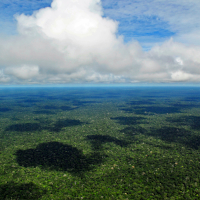
Damaged Amazon Adds to Global Warming
View the page for this story
The first broad study of all greenhouse gases in the Amazon rainforest reveals that on balance the damaged ecosystem is now a net contributor to climate change. Part of the problem comes from local damaging activities like logging, dam-building, and cattle ranching. But planet-wide warming is also disrupting the water cycles in the Amazon, intensifying floods and drought that create more greenhouse gases and further decrease the ecosystem's ability to capture and store carbon emissions. Lead author and professor at Skidmore College, Kristofer Covey, joins Host Steve Curwood to explain the study. (11:36)
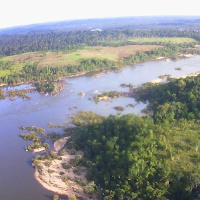
Belo Monte Dam Disrupts Amazon Floodplain Balance
View the page for this story
In a bid to boost electricity production, the operator of the Belo Monte dam on the Xingu River in the eastern Amazon rainforest is drastically reducing river flows for at least a year. Scientists say this will disrupt flood-dependent ecosystems as well as the indigenous communities in the area. Reporter Tiffany Higgins covered this for the news site Mongabay and joins Host Bobby Bascomb to discuss. (13:33)
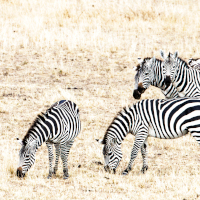
Horse of a Different Color
/ Mark Seth LenderView the page for this story
Living on Earth's Explorer-in-Residence Mark Seth Lender shares his appraisal of an artistic herd of zebras in Maasai Mara National Reserve in Kenya. (02:20)
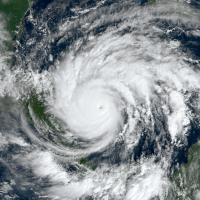
Beyond the Headlines
/ Peter DykstraView the page for this story
This week, Environmental Health News Editor Peter Dykstra and Host Steve Curwood go behind the headlines to discuss the recent decision to retire the use of Greek letters as a way of identifying Atlantic hurricanes. Next, they highlight the appointment of Jane Lubchenco, former head of NOAA, to a climate advisory role in the Biden White House. They also discuss Florida’s new law that bans the private ownership of 16 invasive reptile species. Finally, they look back to March 28, 2001 and then-President George W. Bush’s decision not to sign the Kyoto Protocol. (04:23)
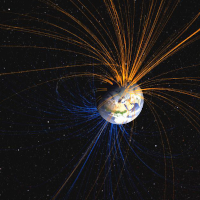
Prehistoric Magnetic Flip Shook Up Life on Earth
View the page for this story
Earth’s magnetic poles wander around and flip every now and then, and now scientists have evidence for how these flips impact life on Earth. Carolyn Gramling wrote about the research for Science News and joins Host Bobby Bascomb to talk about how a magnetic pole reversal about 41,000 years ago is linked to megafauna extinctions, climatic changes, and even a rise in ancient cave art. (10:19)
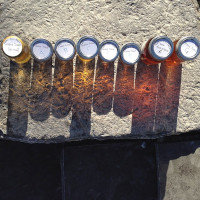
Not Just Maple Syrup: Birch, Beech and Other Sappy Trees
/ Bobby BascombView the page for this story
It’s maple syrup season, but sugar maples aren’t the only sappy trees that can be tapped to make syrup. Host Bobby Bascomb visits syrup producer David Moore in New Hampshire to taste and learn about syrups made from birch, beech, walnut, and other trees. (05:04)
Show Credits and Funders
Show Transcript
210326 Transcript
HOSTS: Bobby Bascomb, Steve Curwood
GUESTS: Kristofer Covey, Carolyn Gramling, Tiffany Higgins
REPORTERS: Bobby Bascomb, Peter Dykstra, Mark Seth Lender
[THEME]
CURWOOD: From PRX – this is Living On Earth.
[THEME]
CURWOOD: I’m Steve Curwood.
BASCOMB: And I’m Bobby Bascomb
The warming planet and deforestation may be flipping the Amazon into a net source of climate changing gases.
COVEY: We have over the past half-century dramatically reduced the carbon sink of the Amazon. And in many cases a bunch of other factors as well were increasing warming. And that change is really what's so frightening.
CURWOOD: Also, unlocking a mystery about the magnetic pole reversal of the Earth some 41,000 years ago.
GRAMLING: We knew that some large, charismatic animals had gone extinct. Weirdly, it was right around this time that you saw this big uptick in cave art, in humans painting in caves. We knew that there were some climatic shifts that occurred around this time. But being able to link them to this event is the real, the real trick.
CURWOOD: That’s this week on Living on Earth – Stick Around!
[NEWSBREAK MUSIC: Boards Of Canada “Zoetrope” from “In A Beautiful Place Out In The Country” (Warp Records 2000)]
[THEME]
Damaged Amazon Adds to Global Warming
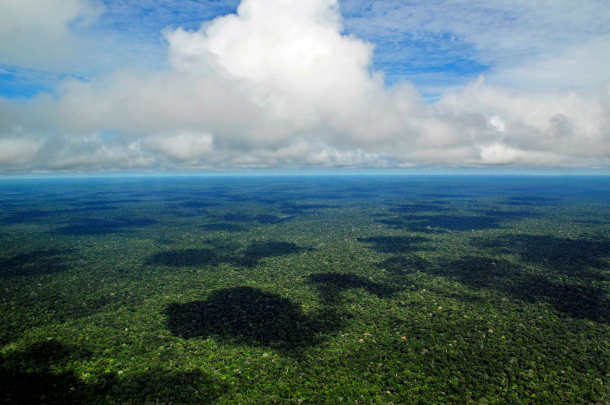
A bird’s eye view of the Amazon Rainforest near the city Manaus. (Photo: Neil Palmer, CIAT, Wikimedia Commons, CC BY-SA 2.0)
BASCOMB: From PRX and the Jennifer and Ted Stanley studios at the University of Massachusetts Boston, this is Living on Earth. I’m Bobby Bascomb
CURWOOD: And I’m Steve Curwood
The vast Amazon Rainforest is now likely adding to global warming. This astounding news comes from research analyzing a wide range of emissions from the tropical forest system, not just carbon dioxide. Part of the problem stems from cutting and burning the forest, as well as dams and cattle ranching that promote the formation of methane. But even more ominous is the concern that the world-wide rise in temperatures is speeding up water cycles, making for extremes between floods and drought, and changing the biochemistry of the rainforest. Not only is the Amazon the most biologically diverse ecosystem on the planet, but its trees also absorb some 2 billion tons of carbon dioxide every year. But the increased release of methane and other powerful greenhouse gases like nitrous oxide appear to be helping tip the Amazon toward adding to climate disruption. For more on this, we turn to the study's lead author and biogeochemist Kristofer Covey at Skidmore College, and he joins us now. Kristofer, welcome to Living on Earth!
COVEY: Well, thanks, Steve. I'm really excited to be here.
CURWOOD: So this is a fascinating and concerning study that you have published here. So what did you find?
COVEY: We realize there's been a ton of climate research that's been done in the Amazon and what we see is obviously, CO2 coming in, CO2 going out. We see fires, the sort of soot that comes off of the fires, that can change the color of the atmosphere, trees transpire water, and that can have a cooling impact. Clearing changes the color of the forest, and that changes the way that sunlight bounces off or is absorbed. We looked at methane emissions, both from wet soils, but also directly from trees. And so what we saw was that when you start to add all of this up and look at the scale of the whole Amazon Basin, that the net effect of that right now appears to us that it's most likely that the Amazon is actually warming climate.
CURWOOD: So I ran out of fingers to count all those factors that you looked at, give me the 4-1-1 about some of them. I mean, traditionally, we talked about carbon dioxide, CO2, humans are forcing more CO2 in the atmosphere, and that's what's warming the planet. But your study says, well, yeah, "CO2, but-" what are those other "buts" in some detail for me?
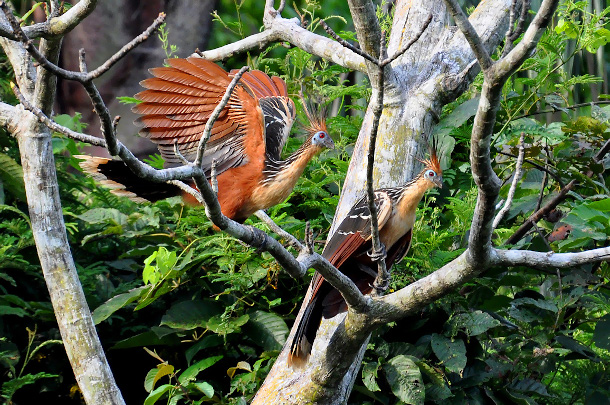
It is estimated that ten percent of the known species in the world is found in the Amazon rainforest. Pictured are two hoatzins, also known as the skunk bird or Canje pheasant. (Photo: Cláudio Dias Timm, Wikimedia Commons, CC BY-SA 2.0)
COVEY: Yeah, so well, CO2, obviously, is huge in the Amazon, you're talking about a continuing reserve of over 100 billion tons. But we also see, for instance, methane as a really important greenhouse gas that comes out of all natural ecosystems. That's not a new finding in any way. What's special in the Amazon is that a few years ago, one of my colleagues, Sunitha Pangala, went out and measured tree bark in the wet, flooded Amazon and found a lot of methane coming directly out of bark. And what's happening is it's being produced in the soil just as it would in any wetland. Well, normally, the water sort of traps that in. But these trees stick the roots down into the soil, and they're drawing that methane out of the wet soil, and they're acting like straws and bringing it up into the atmosphere. It turns out, that's a lot of methane, it's about three and a half percent of all methane put into the atmosphere. Another one, for example, is N2O. It's coming out of soils, it's coming out of trees. It's the result of land clearance, but it's also present before you clear land. And biological volatile organic compounds: they're fascinating because they don't have a whole lot of direct impacts on climate, they can. But their big effect is that they change the way other gases like CH4, for example, break down in the atmosphere. And so all of these impacts are interacting with each other in real time. We've known that this can happen in these systems, but starting to tie it all together onto one balance sheet can be incredibly difficult.
CURWOOD: Yeah, I'm not gonna disagree with you about that. We've been saying the Amazon is the lungs of the planet, and you have to stop cutting it because it's protecting us from climate disruption. But now you're saying it's part of the climate disruption party?
COVEY: Well, I think to say that the Amazon is part of the climate disruption is, is really missing a key part of our understanding of how terrestrial ecosystems work, which is that terrestrial ecosystems all around the world are constantly putting out greenhouse gases, taking them up. And we've actually known for some time, there was a paper published in Nature in 2016, that showed that on the net, all of the world's forests are emitting more greenhouse gases than they're taking up. But this is sort of the natural ecosystem processes. And that total, isn't what matters so much is how we are affecting that total, and the change that results from what we do on a piece of land. And one of our really key findings from looking at all of these things is that the vast majority of human activities in the Amazon: deforestation, mining, conversion to agriculture, this basket of things that we're doing down there, the vast majority of those, increase net warming. So rather than looking at that total, let's look at how we are influencing that total. And that's not a good picture, what we see there is that we have over the past half century, dramatically reduced the carbon sink of the Amazon, and in many cases, a bunch of these other factors as well, were increasing warming. And that change is what's really so frightening.
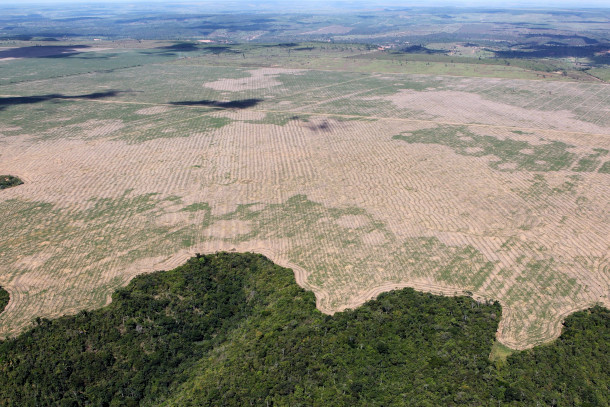
Deforestation in the Maranhão state of Brazil in 2016. By 2018, it was estimated that around 17% of the Amazon had been deforested. (Photo: Ibama, Wikimedia Commons, CC BY 2.0)
CURWOOD: And of course, they're building dams down there, which really can generate a lot of methane.
COVEY: I think the dam issue speaks to the tremendous complexity of the environmental challenges that we face. Because energy, obviously, if you read through the IPCC report, and look at where our emissions are coming from, and where the pathways that will get us to a sustainable climate are, many of them have to do with zero carbon energy. And then you put in a dam in the Amazon that's making low carbon or zero carbon energy, but we have to be concerned about the fact that we've just inundated a huge area and we're going to have a giant pulse of methane that's going to be released to the atmosphere. And I think that's another key point that we're trying to make with the paper is that we're going to be leaning increasingly on these ecosystems, not only for climate, but for a huge number of benefits. And so what we need to do is put as many of these arrows onto the diagram, understand them in as much depth and complexity as we can, and try and really embrace the complexity of the challenges facing the environment ahead. If we can't do that, we're not going to find ourselves on a sustainable path going forward.
CURWOOD: Kris, to what extent is there a feedback loop of warming now happening in the Amazon?
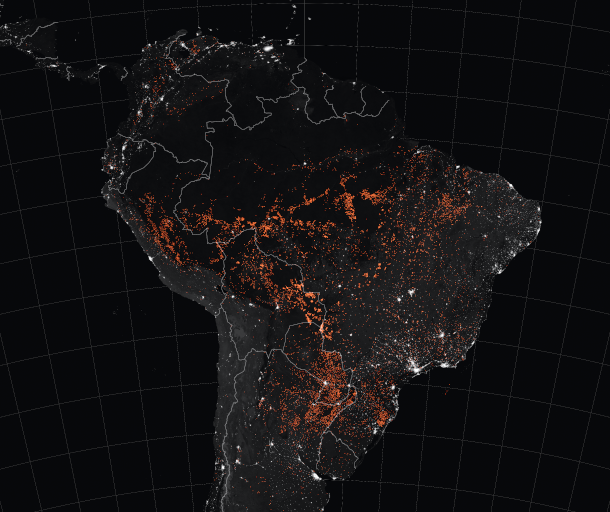
As warming and slash-and-burn deforestation continues, the Amazon rainforest becomes more susceptible to uncontrolled forest fires. The orange dots on this image mark the location of fires between August 15th and August 22nd in 2019. (Photo: Joshua Stevens, using MODIS data from NASA, Wikimedia Commons, public domain)
COVEY: Yeah, that's a great question. And something that I think is right at the front of climate researchers minds in the Amazon. And and I think that there's a pretty clear conceptual framework and the beginning of really good measurements to show that, as the Amazon warms, we're seeing the drought season come on earlier, we're seeing it last longer, potentially getting drier. And with that then, that's driving tree mortality. And dead trees burn a lot easier than live trees. And so then we're seeing the fire seasons being much more dramatic, burning much larger areas. And then as that happens, of course, as my colleague, Tom Lovejoy, who's on the paper, pointed out with Carlos Nobre a couple years ago, we're approaching very rapidly this point where the ecosystem itself is at the edge of potential collapse. The trees drawing moisture out of the ground, are seeding the rainfall that makes the Amazon a rain forest. And so you can see yourself, as you cut one tree, there's a little less moisture in the atmosphere as you cut the next tree, there's a little bit less. And so there's a conceptual last tree, where this isn't a rainforest anymore. And climate exacerbates that process and puts us closer to that tipping point.
CURWOOD: So we're talking about the Amazon, but it's not in isolation, we have an overall warming planet. And we're seeing also, especially from the High Arctic, with the warming a lot of releases of warming gases, methane and CO2. To what extent is the is the Amazon really caught in this overall feedback loop we have going on on the planet, do you think?
COVEY: Yeah, well, I think the Amazon is both at the center of that and a symptom of that, right? So the Amazon is feeding back into global climate where now it's now very clear that the degradation there has reduced to the carbon sink, to the point where we can start having conversations about whether there is a general carbon sink there anymore. And then that, of course, the release from the black carbon from all of the fires going into the atmosphere is warming, that warming is most extreme at the poles. And so it's an interesting story about the interconnectivity of our entire planet, right, warming from the Amazon is then driving warming in the Arctic. And along with a bunch of other places, we're starting to have this conversation around tipping points. And all of these tipping points are interconnected, it starts to bring to mind some of these tail risk scenarios that we talk about in climate change.
CURWOOD: So what's the solution here?
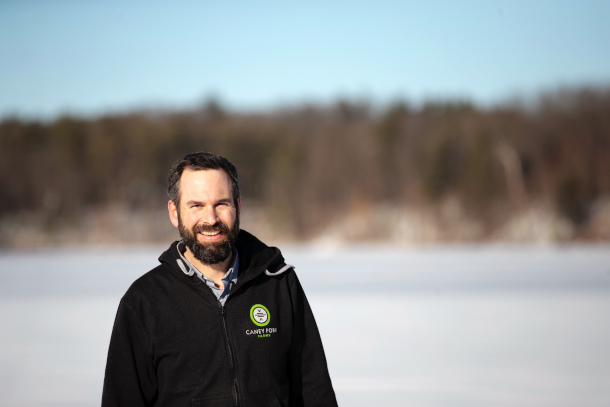
Kristofer Covey is a biogeochemist and Visiting Assistant Professor at Skidmore College. (Photo: Courtesy of Sarah Condon-Meyers)
COVEY: Well, I think the first thing I want to say is that the solution is certainly not to keep deforesting the Amazon, there is no silver lining to deforestation. Climate aside, let's assume for a second, there were no climate change. Wouldn't that be wonderful? Even in that case, the Amazon is still the largest store for biodiversity on the planet, it still has this gorgeous and unique river network unprecedented on the planet. It's still home to countless indigenous people who depend on it for their daily existence, right? And so there's so much to be had from protecting and restoring this great forest. And so I would say the solution is protect and restore. So how do we do that? We look at the social drivers of change. And we engage with the communities on the ground, with the people on the ground who are working at the source to halt deforestation, working with local communities, and working on integrated solutions to those problems.
CURWOOD: So the Amazon basin covers much of South America but the bulk of it, I think 60%, is in Brazil. Now the US is currently talking with Brazil about the environment prior to the big international negotiations on climate known to the UN as COP26. What are your hopes for a conversation between the United States and Brazil leading up to those climate negotiations?
COVEY: I've been happy to see some small attention in the news asking for the Biden administration to apply pressure on deforestation in Brazil in particular. And obviously, there are huge considerations in the geopolitical relationship between the United States and a massive country like Brazil. There should be a lot of things in those negotiations probably as complicated as the biogeochemistry of the Amazon, right? But as someone who's just spent a couple years with people who've been working for many, many years in that region looking at deforestation, thinking about its impact on global climate. From my perspective, if there were ever a time to expend some political capital, trying to save some natural capital, this is the time and so I would encourage the Biden administration to put deforestation at the center of its conversation with Bolsonaro and his administration.
CURWOOD: Kristofer Covey is a biogeochemist and teaches environmental studies and science at Skidmore College. Thank you so much for taking the time with us today.
COVEY: Thanks, Steve. Appreciate it.
Related links:
- National Geographic | “First Study of All Amazon Greenhouse Gases Suggests the Damaged Forest Is Now Worsening Climate Change”
- Access the study here
- Learn more about Kristofer Covey here
[MUSIC: Airto Moreira, “Alue” on Alue, by Airto Moreira and Flora Purim, Selo SESC SP]
BASCOMB: Coming up – We’ll stay in the Amazon for the story of a dam and its impact on biodiversity. Keep listening to Living on Earth.
ANNOUNCER: Support for Living on Earth comes from Sailors for the Sea and Oceana. Helping boaters race clean, sail green and protect the seas they love. More information at sailors for the sea dot org.
[CUTAWAY MUSIC: Benny Goodman, “Ain’t Misbehavin’” on B.G. In HiFi, by Thomas “Fats” Waller/Harry Brooks, Blue Note Records]
Belo Monte Dam Disrupts Amazon Floodplain Balance
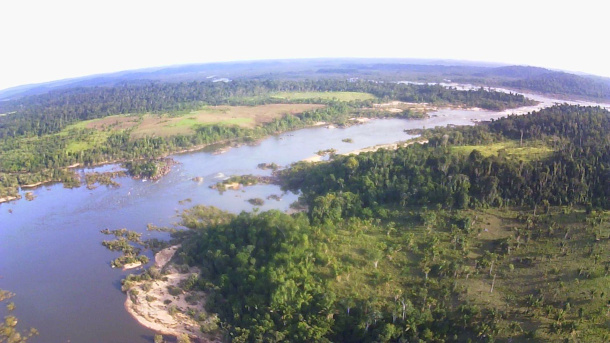
Drone documentation of low water on February 13, 2021 after North Energy's Hydrogram B cut 85% the Xingu River’s flow into the Volta Grande. (Photo: Courtesy of Tiffany Higgins)
CURWOOD: It’s Living on Earth, I’m Steve Curwood.
BASCOMB: And I’m Bobby Bascomb
Brazil has built more than 200 large hydroelectric dams as a way to produce energy for a growing economy and wants to build hundreds more in the Amazon. But the initial flooding behind dams can add to climate change by killing trees and other vegetation, which decompose and release the potent greenhouse gas methane. At the same time the diversion of water from naturally flowing rivers to fill dams can disrupt ecosystems that are dependent on periodic river flooding to help feed people, fish and reptiles. One of the most controversial dam projects in Brazil is the Belo Monte dam on the Xingu River in the eastern Amazon, homeland of several indigenous tribes, including the Juruna. Charts called hydrograms show Norte Energeia, the Belo Monte dam builder, has begun drawing down some 85% of the river. Tiffany Higgins has been digging into the story for the news site Mongabay and explains the yearly pulse of water that should flood the forest right about now.
HIGGINS: There’s an annual flooding that happens, where the water level rises and grows very, very, very fast, up to 23,000, 25,000 cubic meters per second. And this means that the water swells beyond the margins of the river, and it floods into the flooded forest. And there are special trees that are adapted to being seasonally flooded. The turtles and the fish around February they catch this river wave into the flooded forest. And it's an amazing synchrony, developed over millennia, between the trees that are fruiting and maturing just at this time of year, and the fish and turtles who come along – they ride this river wave into the forest. The fruiting trees drop their guavas, figs, tucum, cashew fruits, the golosa fruits, and they ripen and drop into the water into the flooded margins. And then the fish and turtles scoop it up. And this gives them essential calories to be able to reproduce. If they don't have these extra calories, which they couldn't access in the mainstem of the Xingu river, then they don't have enough energy to reproduce.
BASCOMB: And this is the time of year when they're reproducing right?
HIGGINS: This is the exact time of year when they're reproducing. It's called the piracema, which is from the Tupi native words. It's something that all the fisherfolk communities are totally oriented to.
BASCOMB: So starting in February of 2021, Norte Energia or North Energy, they diverted about 85% of the water that would have flowed into the Volta Grande for the Belo Monte mega dam. Why did they suddenly need to divert so much water? Was this always part of the plan there?
In October 2020 on the Volta Grande of the Xingu River, low river flows uncover rocks, making navigation more challenging. Norte Energia’s newly implemented “Hydrogram B,” implemented in February 2021, will bring yearly average flows lower than in 2020. (Photo: Courtesy of Verena Glass)
HIGGINS: This was written into the original plan. Yes, back in 2009. And at that time, IBAMA, the environmental agency of Brazil, their technical team specifically criticized what the company dubs Hydrogram B. Essentially Hydrogram B means that the very highest point of water releases to the Volta Grande would be 8,000 cubic meters per second in April. April is always the peak. However, 20,000 cubic meters per second is the [historical] average [in April] on the Volta Grande. So the company has been trying to implement this Hydrogram for a long time. The company signed an agreement, more than a decade ago, that its license was dependent upon them maintaining life on the Volta Grande. So in December 2019 IBAMA's technical team said that Norte Energia had not proven scientifically that that they could maintain the ecosystem on the Volta Grande. And they told them to go back and do studies to prove that. But instead, what happened is that the president of IBAMA stepped in, Eduardo Fortunato Bim, and he made an agreement with the president of Norte Energia to allow them to implement the Hydrogram B. They did not defend it. The president didn't defend it, he simply said, Go ahead, you can implement this Hydrogram B for a whole year, but there was no scientific evidence given for it. So the experts I talked with, as well as the people on the Volta Grande, say this is a politically motivated decision.
BASCOMB: And how might this lower water level affect the wildlife and the indigenous people who live in the area? What are scientists thinking might happen as a result of this?
HIGGINS: In 2016, when El Niño occurred, we had a kind of natural test case for what this year 2021 is going to look like on the Volta Grande. So the Juruna observed fish that were very skinny. You know, they’re supposed to have scales on them, some were smooth, and many of them they would cut them open and see that their eggs were dry, or their eggs had been reabsorbed into their bodies. As far as the turtles, they saw many turtles who were only bone, they had very little flesh on them. And when they cut the turtles open, they found that where there should be eggs, there was foam instead. It goes without saying that they can't eat sick animals, right. They noticed a clear change in the taste to acidic, bitter, and they weren't able to, to eat them, so this affects the people. And let's notice that this is a higher Hydrogram than is going to happen in 2021. So you're going to have all those effects on animals, but even worse. So that 10,000 cubic meters per second was in April, was the amount of water in 2016. But now we're gonna have 8,000 cubic meters per second in April in 2021, so we can expect even more disastrous effects on the animals.
BASCOMB: Wow. Well, I mean, and that was a natural thing. You know, El Niños happen. But this is a manmade disaster that you're saying is expected to be even worse than that year which was so devastating for both the wildlife and people.
HIGGINS: Exactly. People I talked with said this violates a wide range of laws, both international and national laws. The Article 231 of the Brazilian Constitution says that hydroelectric dams cannot interfere with indigenous territories. But this is exactly what's happening. Other conventions safeguard the fishing stock of indigenous communities. In essence, you can't remove the food basis of a community.
BASCOMB: And I understand that we have a recording here that you've shared with us from Bel Juruna. She's a member of the Juruna indigenous group that lives in the area. And I believe she's talking about the low water levels that she's seeing already. Let's take a listen:
JURUNA: E como agora [a água] não vai chegar mais, aquelas [plantas aquáticas] vão morrer. Então a Volta Grande vai se tornar um cemitério, vai ser um cemitério de peixes, um cemitério de árvores mortas. E a gente vai estar aqui. A gente quer resistir neste lugar, né? Lutando para que a gente possa também não ser – não virar um cemitério também dentro da aldeia.
BASCOMB: What is she saying here, Tiffany?
HIGGINS: So Bel is in the Mïratu Village of the Paquiçamba Indigenous Territory where the Juruna people live. And she's showing the low river levels once the company was permitted to to drop them down, cutting the natural river level by more than 85%. She says, "This will be a cemetery of trees, this will be a cemetery of fish." And she says, "And so we Juruna we will be here fighting so that we too won't become a cemetery in our village." She's being quite literal here. Jansen Zuanon, a scientist I talked with, said that [in] the forest there are special trees that are totally adapted to being seasonally flooded. So when she says cemetery of trees, it's not just metaphorical, it's literal. Because Jansen Zuanon told me that they will experience functional death if these trees are not able to be flooded. I talked with a scientist Camila Ribas who is an ornithologist who told me that 60% of the birds that are in that flooded forest, they're adapted only to the flooded forest. So when the forest dies, these special kinds of birds are going to die off as well. It'll create a wide patch of deforestation in this forest that will cut off the biological continuity. This wildlife corridor between what's called the upper Xingu River and the lower Xingu River. This is at a time when Brazil has really come to the attention of the world as needing to do something about – to stem deforestation.
Lorena Curuaia (left), a leader of the Curuaia people, of the Iawá village on the Volta Grande, walks with children in 2020. (Photo: Courtesy of Todd Southgate)
BASCOMB: Now, I understand that Norte Energia did come up with some plans that they thought could maybe mitigate the damage to wildlife in the river. Can you tell us about that?
HIGGINS: Right. So Norte Energia committed 157 million reais, which is $28 million in US currency, to what they call mitigation plans. There were three projects approved to send teams to collect fruit and leaves from the forests that should have been flooded, and then throw those into the river where the fish are kind of captive, right, because they can't get to the flooded forest. That's one project. The second one is to have floating platforms that have bushes and trees on them, supposedly to feed the fish, again, with the concept that they can't actually get to the fruiting trees anymore because of the diminished flow, and then third, raising fish in captivity and then releasing them. So I wanted to know, Could these work? So I asked a few scientists about this. Juarez Pezzuti from the Federal University of Pará said that these are scientifically unproven plans. He said, “It's an absurd pseudo-project, impossible to be executed on a scale that compensates for the absence of flooding of tens of 1000s of hectares.” He said that the first two projects aren't based upon any kind of precedent. They're totally unproven scientifically, and then the raising of fish in captivity, that there are numerous studies proving them to be ineffective.
BASCOMB: And what did Norte Energia say when you contacted them for this story? And I'm sure you you outlined all of these concerns for that people, the environment, the fish and the forest. What did they say to you?
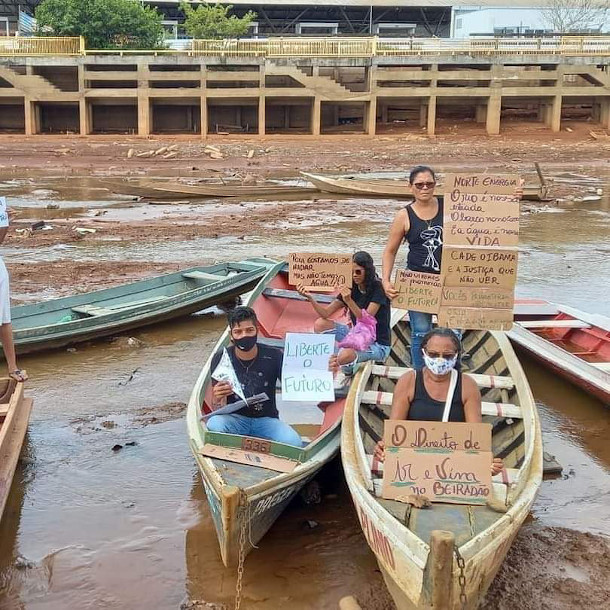
Communities of the Volta Grande protesting the Belo Monte dam operator Norte Energia in October 24, 2020 for the role it had in reducing the flow of the Xingu river and the biodiversity in the region. The members of the Youth Collective for Social and Environmental Justice on the Middle Xingu hold signs reading: “Release the Future,” referring to water releases, “The right to come and go along the shore,” “Norte Energia, the river is our doorway, the water is our life,” and “Where is IBAMA? and the Justice Department, that doesn’t see?” (Photo: Courtesy of Youth Collective for Social and Environmental Justice on the Middle Xingu)
HIGGINS: Right, so Norte Energia, they stated that there is no technical scientific proof that the company's hydrogram, i.e. Hydrogram B, will cause any harms to the animals, the fish, and turtles of the Volta Grande. In addition, they said we have robust scientific monitoring. It's a kind of a little bit of a perverse logic, right, because they're the ones that are doing the monitoring and they say, there's no proof, that there was no proof that this is actually gonna hurt any animals. However, they didn't consider any alternatives, so they have nothing to compare it to. And I interviewed scientists saying that the quote, unquote, monitoring studies that Norte Energia does are extremely flawed, their measurements are not accurate. For example, they don't actually monitor fish, they monitor fishing. So if it takes a fisherperson three days to get a certain amount of fish using 20 nets, or whether it took them three hours to do it, they don't measure that difference. So they've been able to claim therefore, Oh, the amount of fish being caught at the river ports is staying the same. But they don't, they don't measure how much effort and how long it took to actually catch that amount of fish.
BASCOMB: Tiffany Higgins is a freelance reporter. Tiffany, thank you so much for taking this time with me today.
HIGGINS: Thank you so much, Bobby. I've enjoyed the conversation.
BASCOMB: For a link to Tiffany’s original story in Mongabay and a video of Bel Juruna showing the changes to the Xingu River, visit the Living on Earth website, Loe.org.
Related links:
- Mongabay | "Amazon’s Belo Monte dam cuts Xingu River flow 85%; a crime, Indigenous say"
- Mongabay | “Belo Monte Dam’s Water Demands Imperil Amazon Communities, Environment.”
- On March 25, 2021 the Federal Prosecutor in Altamira (Ministerio Publico Federal) filed a public civil suit against Norte Energia, the Belo Monte dam proprietor, and Ibama (Brazil’s environmental agency), over what they call excessive diversion of the Xingu River away from the Volta Grande. Click here to access the public civil suit
[MUSIC: Fabian Beghin & Didier Laloy, “One More Night On the Train,” by Fabian Beghin, Home Records]
Horse of a Different Color
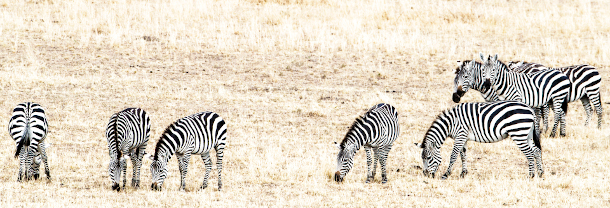
A herd of zebra graze in Maasai Mara. (Photo: Mark Seth Lender)
CURWOOD: Prey animals have evolved strategies to evade predators. Some are fast and agile, like rabbits. Some are slow like snails and turtles but they have hard shells for protection. Our Explorer in Residence, Mark Seth Lender, has this story of an animal that simply finds great safety in numbers.
LENDER: Zebra are making themselves painterly. Spreading out. Milling about. Closing the gap. Becoming a knot a knitting a… Tapestry. Abstract. Abstruse. Neither close nor distant on first glance and are they Herd (Indivisible) or Horse (Invisible)?
Or both?
That’s the trick of it.
And whether White Horse herd in shadow or a Dark Horse herd in light, even the predators (for whom disambiguation is their only business) struggle to get it right. There are too many decisions to make!
Which is the point of it.
The lioness furrows her brow (did those flashing lines give her a migraine?). The leopard stares and blinks, as if he cannot focus (has he had too little sleep?).
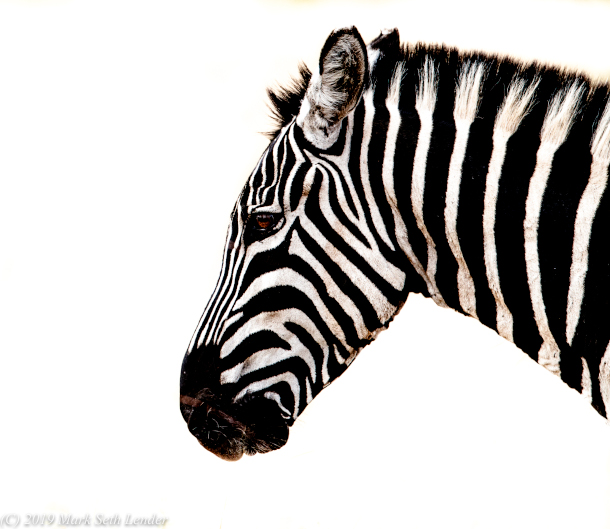
A close-up on a single zebra. (Photo: Mark Seth Lender)
Jackal packs it in.
Wild Dogs loll their tongues and sit down on their haunches (as if they have to have a think).
White-backed Vultures (they know what it’s all about) repeat their mantra silently: circle, circle, wait… wait...
While spotted hyena (being opportunists) will let the Nile crocodiles sort it all out.
Well, Zebra did not have to go to finishing school to learn that Living is an Art, that One alone is decoration and strength in numbers is the only way to save your hide. It is not wisdom, just a Fact of Nature there is great danger all by yourself. Those are the breaks. There’s little bending.
Going it Alone and Lonely never wrote a Happy Ending.
CURWOOD: That’s Living on Earth’s Explorer in Residence, Mark Seth Lender.
Related links:
- Read the field note for this essay
- Learn more about Mark Seth Lender's stories and adventures
- Learn about Destination: Wildlife
[MUSIC: Vusi Mahlasela “Loneliness” on The Voice (of the People)-Ilivi Lebantfu, by Vusi Mahlasela, ATO Records]
Beyond the Headlines
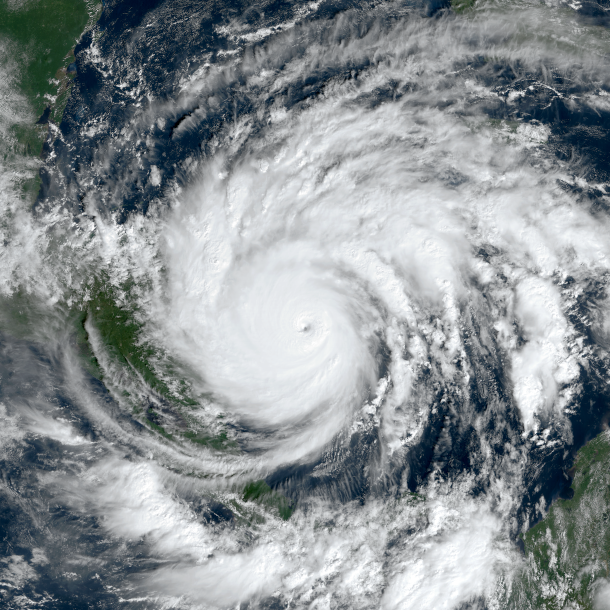
Hurricane Iota, a category 5 storm that caused devastating damage in Central America in November, 2020. The 2020 Atlantic hurricane season was the second to ever extend past the list of 21 prepared storm names and into the Greek alphabet. Use of the Greek alphabet is now being retired. (Photo: NASA)
CURWOOD: With me on the line now from Atlanta, Georgia is Peter Dykstra. Peter is an editor with Environmental Health News, thats EHN.org and dailyclimate.org. At this time in the broadcast, we like to ask him what's going on beyond the headlines. And Peter, what are you going to say?
DYKSTRA: Last year, the Atlantic hurricane season went way into the Greek alphabet. Of course, they use sequential male and female names to name hurricanes. There are 21 on the list each year, they leave out letters like Q and X, Y, Z. When they ran out, they went to the Greek alphabet. Hurricane Zeta, Eta and Iota were big ones. The World Meteorological Organization is looking to not only extend the season on both ends, but they also want to ditch the concept of using Greek names after the 21 alphabetically ordered names run out for the hurricane season. 2020 was the second time that ever happened, the first time was back in 2005, the year of Katrina and Rita.
CURWOOD: To what extent is this all related to climate disruption?
DYKSTRA: Well, scientists have told us that the changing climate is going to make hurricanes more intense. We've seen a lot of category fours and category fives in recent years, that unfortunately looks like the scientific prediction is coming out to be true.
CURWOOD: Well, its the warmer water. Hey, what else do you have for us today?
DYKSTRA: Well, briefly, there's one other big item on the climate and meteorological front. Heavy hitter, former head of NOAA, former head of the American Association for the Advancement of Science Jane Lubchenco has joined the Biden administration in an advisory role that will weigh heavily on climate and add to the heavy hitters like former EPA Administrator Gina McCarthy, and former Secretary of State John Kerry working on climate for Joe Biden.
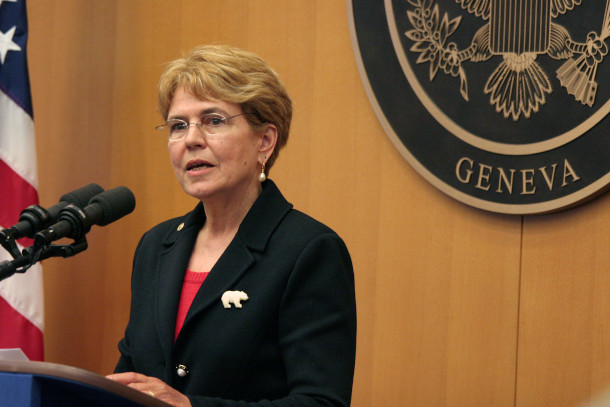
Dr. Jane Lubchenco, former head of NOAA and the American Association for the Advancement of Science, speaking at the U.S. Mission to the United Nations in Geneva in 2009. Lubchenco was recently appointed to a key climate advisory role in the Biden administration. (Photo: Eric Bridiers via Flickr, CC 2.0)
CURWOOD: It would appear that the Biden administration is quite serious about taking on climate disruption. What else do you have for us today?
DYKSTRA: Florida has banned the import or ownership of 16 invasive reptile species, animals like the gray iguana, and particularly the Burmese python, which is bought at pet shops or in markets. People bring the Burmese python home. All of a sudden, they've got an animal that could be 15 or 20, or even 25 feet long. No longer is it a fun pet to have. They're dumped, often in the Everglades, where Burmese pythons thrive so much that they've essentially overwhelmed native species and really tipped the balance in the Everglades. Those pythons and other reptiles are now going to be illegal even to have, not just to sell.
CURWOOD: Hey, Peter, let's take a look back now, at the history books. Tell me what you see.
DYKSTRA: Well, there's a 20th anniversary. First of all, it just blows my mind that we can have a 20th anniversary, and we're still talking about an event in the 21st century. But on March 28th, 2001, the new President George W. Bush, for all intents and purposes, ended consideration of the US joining the Kyoto Climate Treaty. He announced that he would refuse to sign the treaty. That adds to what's become a sad tradition of any contentious treaty failing to have US participation. The other big environmental one that's been going on for 40 years is the Law of the Sea treaty that would deal with things like deep sea mining, which is now being seriously considered by several countries.
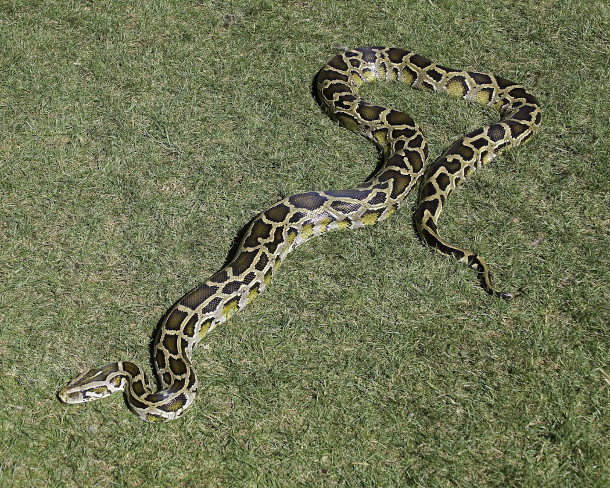
Burmese Pythons are one of the world’s largest snake species. Native to Southeast Asia, they are invasive in Florida and have caused widespread ecological disruption, particularly in the Everglades. (Photo: Allan Hack via Flickr, CC 2.0)
CURWOOD: The Constitution says the Senate has to give a two thirds vote to approve it, kind of feels like the filibuster. You gotta wonder if the Constitution had said the majority of both houses of Congress would approve the treaty that we might have these treaties but it's hard to speculate today.
DYKSTRA: It's hard to see any treaty on any subject getting two thirds approval in such a harshly divided Senate.
CURWOOD: Peter Dykstra is an editor with Environmental Health News, that's EHN.org and dailyclimate.org. We'll talk to you again real soon.
DYKSTRA: All right Steve, thanks a lot. Talk to you soon.
CURWOOD: And there's more on these stories on the Living on Earth website, that's LOE.org.
Related links:
- The New York Times | “The Greek Alphabet Will No Longer Be Used to Name Hurricanes”
- Environmental Defense Fund | “Jane Lubchenco Joins Biden All-Star Climate Team”
- The Washington Post | “A Reptilian Nightmare: Florida Bans Nonnative Species Despite Industry Outcry”
- The Guardian | “Bush Kills Global Warming Treaty”
[MUSIC: Johnny Burgin with special guests No Border Blues Japan, Samurai Harp Attack on No Border Blues Japan, Delmark Records]
BASCOMB: Coming up – Maple isn’t the only option for tapping sweet trees in the springtime. Keep listening to Living on Earth.
ANNOUNCER: Funding for Living on Earth comes from you, our listeners, and United Technologies, combining passion for science with engineering to create solutions designed for sustainability in aerospace, building industries, and food refrigeration.
[CUTAWAY MUSIC: Vusi Mahlasela, “Mme Modiane” on The Voice (of the People)-Ilivi Lebantfu, by Vusi Mahlasela, ATO Records]
Prehistoric Magnetic Flip Shook Up Life on Earth
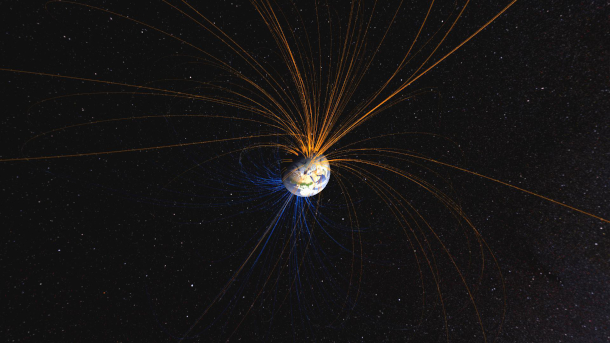
Earth’s magnetic field connects the north pole (orange lines) with the south pole (blue lines). (Image: NASA Goddard Space Flight Center)
CURWOOD: It’s Living on Earth, I’m Steve Curwood.
BASCOMB: And I’m Bobby Bascomb
If you’ve ever used a compass you have probably noticed that it doesn’t exactly point straight to the geographic north pole, but rather to the magnetic north pole north of Hudson Bay in Canada. And recently the magnetic north pole seems to be shifting about 40 miles a year toward Siberia. In the deep past the Earth has even completely reversed its magnetic poles, and the exact reasons for the flip flops aren’t well understood. But thanks to a fossil tree discovery in New Zealand, scientists are getting more insight on how magnetic pole reversals could affect life on earth. The tree dates a magnetic flip about 41,000 years ago when there was a shakeup of life on our planet. For more, I’m joined now by Carolyn Gramling. She is the Earth and Climate writer at Science News. Carolyn, welcome to Living on Earth!
GRAMLING: Thank you. It's great to be here.
BASCOMB: So what exactly causes the magnetic poles to flip every few hundred thousand years, and how do we know it's happening?
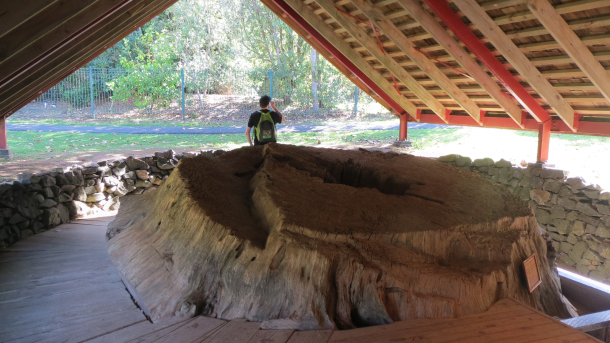
A giant stump of the same kind of tree, the kauri, that gave scientists a “Rosetta Stone” to link together a magnetic pole reversal and other events around 42,000 years ago. (Photo: Sheila Thomson, Wikimedia Commons, CC BY 2.0)
GRAMLING: So that is actually an excellent question. And we don't know really what is causing it to happen. What we do know is that Earth has a metallic core, it has a liquid metal outer core, and a solid metal inner core made of iron and nickel. And the interaction between these two cores, and the flow of the minerals within them, actually generates a magnetic field -- generates an electric current, which generates a field. And what we do know is that this magnetic field is, you know, it's like a giant bar magnet at the center of the planet. So it has a north pole and has a south pole. And throughout Earth's history, for millions and millions of years, we know that those poles have occasionally reversed themselves, so that the north pole becomes south, and south becomes north. And we don't really know why that happens. But we know that in the last 20 million years or so that's happened maybe every 200 to 300,000 years. The last time a big reversal happened was about 800,000 years ago. But there are smaller little blips that occur from time to time. And the most recent one of these that we know of was about 41,000 years ago. And they call that the Laschamps Excursion. And it only lasted for a few hundred years, we think. We know this from the rock record, because when rocks are forming, the tiny magnetic minerals that are inside those rocks can orient themselves to align with the current magnetic field, whichever way it's going. And so we see in the rock record, we see these flip flops from time to time. And we saw about 41,000 years ago that there was a period of time when the magnetic field became really weak. And then it reversed itself. And then it reversed itself back. And this whole thing lasted maybe 1500 years, it was a very short, short excursion. But people are very interested in it, because it was recent enough that we're hoping that maybe there's some way that we can figure out: does this kind of event actually affect the creatures living on Earth at the time?
BASCOMB: So this pole reversal was about 41,000 years ago, from what I understand. But scientists are really interested in what happened just before that, is that right?
GRAMLING: Yeah, that's right. So the, yeah, the reversal was 41,000 years ago. But right before the poles actually switched, there's a sort of period of time where they're sort of getting ready to switch. And that lasted even longer than the actual reversal event, maybe about 1000 years. The magnetic field was actually at its weakest during that pre reversal period, it was down to maybe 6% of its current strength. So the big danger period was the period actually around 42,000 years ago, right before the reversal actually happened.
BASCOMB: And so what exactly did happen to life on Earth at that time?
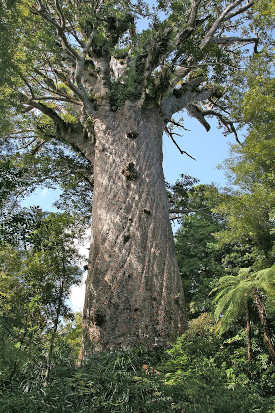
The largest living kauri tree today is called Tāne Mahuta, which is Māori for “God of the Forest”. It’s estimated to be between 1,250 and 2,500 years old. (Photo: W. Bulach, Wikimedia Commons, CC BY-SA 4.0)
GRAMLING: So the trick was, it's such a short period of time that you really need very, very precise dates to be able to, like, link all of these events. So we knew that some large, charismatic animals had gone extinct. Weirdly, it was right around this time that you saw this big uptick in cave art, in humans painting in caves. We knew that there were some climatic shifts that occurred around this time. But being able to link them to this event is the real, the real trick. And so what these guys were able to do was find, basically the Rosetta Stone that they felt could connect all of these events together in time and show they all occurred right around the same time, which was around 42,000 years ago. And that Rosetta Stone was this ancient tree that had been dug up out of a swamp bog in New Zealand.
BASCOMB: Tell me more about that tree, what did the tree show them?
GRAMLING: So the tree, these are trees that, some of them are still living in New Zealand today. They're very ancient coniferous trees, they sort of tower over the forest, they're really distinct. Their antecedents have been around since the Jurassic, so millions and millions of years ago. But these particular trees in this peat bog date back to maybe 50,000 years ago, roughly the right time period. And there's a lot of these giant old trunks, some of them, you know, several meters in diameter, just buried in these bogs and have been preserved there for all this time. And people have been digging them out over time for, for a lot less savory purposes, to use them as like tabletops, or pillars. And that's something that the New Zealand government is cracking down on. But also they're important to science, because they have these very large records of what happened to the climate during this really interesting period of time. And it so happened that in 2019, this one tree was dug up that dates to the exact period of time that we're interested in here. So it was really in the right place at the right time. And researchers were very excited because they knew if we're looking for something that can tell us what happened to the climate 41 to 42,000 years ago, maybe this tree could do it.
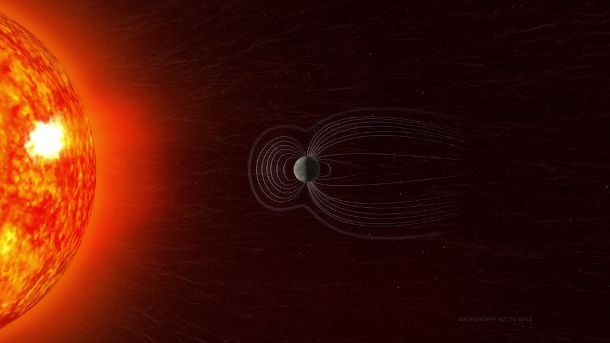
Solar radiation streams across space and hits Earth’s magnetic field, which acts like a protective shield around the planet. Note: Sun and Earth not to scale. (Image: NASA Goddard / Bailee DesRocher, public domain)
BASCOMB: And how did the tree do that? I understand that they used carbon dating with it.
GRAMLING: That's right. Yeah, so they can, they basically look at the, the rings of the tree and they can actually see how much carbon-14 was in the tree over time. And carbon-14 is particularly interesting, not just for dating it for age, but also because when you have a weakened magnetic field, you get all these extra cosmic rays coming into the planet. And those cosmic rays interact with molecules in the atmosphere to produce lots and lots of carbon-14. So you see this giant spike in carbon-14 in the tree, and then you can also date that. So they had this really nice record of like, here's what happened to carbon-14 over time. And they can use that to compare with the rock record, and say, okay, we know these things were coincident, isn't that interesting?
BASCOMB: Well, how could a magnetic pole reversal like this have these kinds of dramatic effects on life on Earth?
GRAMLING: What they found was that you end up producing a lot of molecules in the atmosphere that then interact with ozone in the stratosphere. And as we know, when you're eating away the ozone in the stratosphere, you got a problem. So you end up, as a result, increasing the amount of solar radiation that makes it to the surface of the earth. Another thing that happens is that you change how much heat is coming in to the poles relative to the equator. So like, there's more heat at the poles and before, and that changes how the winds move in the high atmosphere, the jet stream, and you end up getting these different atmospheric shifts. There's some evidence at least around the Pacific Ocean, that there was increased glaciation around that time as well.
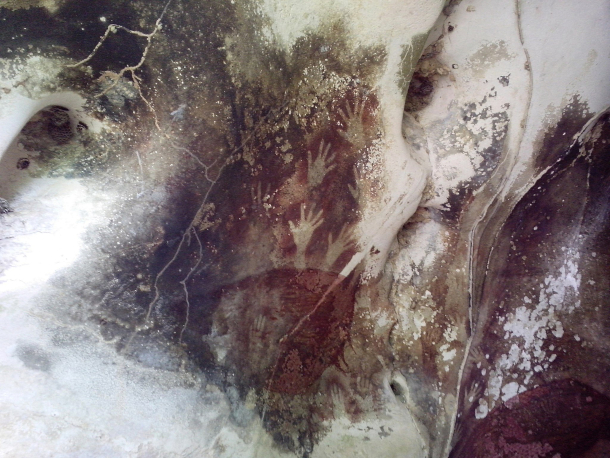
Red ochre cave art in Pettakere Cave in Indonesia dates to around 42,000 years ago. (Photo: Cahyo Ramadhani, Wikimedia Commons, CC BY-SA 3.0)
BASCOMB: And of course, 42,000 years ago, our own ancestors were living across much of the world. How do we think this magnetic field reversal affect them?
GRAMLING: Yeah, that's a really interesting angle for this. There is a documented rise in cave art right around 41, 42,000 years ago. And they know that because in the caves, you get the cave paintings. And then over those, over time, you might get stalactites and stalagmites growing and you can date those growths. And so they know that this rise in these paintings occurred around that time. And they also saw these paintings that had these red outlined handprints, made out of red ochre. And it turns out that in some indigenous communities, they still use red ochre today as a sunscreen. So, is it possible that you have this extra UV radiation coming in, and all of a sudden you have humans in caves more, making this cave art with the red ochre paint, is it possible that that could have been because they were taking shelter from the increased radiation from the sun during that time?
BASCOMB: And using more sunscreen.
GRAMLING: And using more sunscreen, yes!
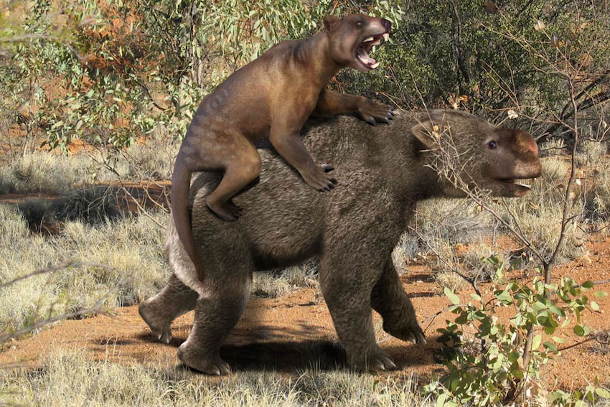
Thylacoleo, the marsupial “pouch lion”, depicted attacking the giant wombat Diprotodon. Both megafauna went extinct around 42,000 years ago. (Image: roman uchytel, Wikimedia Commons, public domain)
BASCOMB: And it was around 40,000 years ago that Neanderthals actually went extinct. To what extent do you think there's a relationship there?
GRAMLING: That's also one possibility, that with the rapidly changing climate, it may be that humans were able to outcompete Neanderthals for whatever resources were becoming more scant. And of course, there were these megafauna extinctions, particularly in Australia, they note, for example, there was a giant kangaroo that went extinct around that time, and some other strange Australian animals. There was a type of carnivorous marsupial, sometimes called a pouch lion, that went extinct. A bucktoothed wombat, that stood at about six feet tall. So all of these things were happening right around that same time.
BASCOMB: And so fans of the book Hitchhiker's Guide to the Galaxy will be interested to learn that there's also a connection there. Can you tell us about that?
GRAMLING: Yeah, this is one of the things that I thought was super fun about this was, because what they were zooming in on was this period of time, right around 42,000 years ago, they called it the Adams Transitional Event, named after the author Douglas Adams, who wrote The Hitchhiker's Guide to the Galaxy series, among other books, and also claimed that 42 is "the answer to life, the universe and everything".

Carolyn Gramling is the Earth & Climate writer at Science News. (Photo: Courtesy of Science News)
BASCOMB: Maybe he was onto something there!
GRAMLING: [LAUGHS] Maybe! So yeah, that's a nice tribute to Douglas Adams.
BASCOMB: Well, Carolyn, what do we know about when the Earth might have another pole reversal?
GRAMLING: So in the last 170 years or so, people have tracked that the strength of our magnetic field has decreased by about 9%. So there are some people who are wondering, are we in the middle of a pre, pre-reversal period right now? Is that, is that what's happening? There are also, in the last decade or so the magnetic north pole was wandering a bit oddly, and so there was some concern like, is it about to flip again? The last big magnetic reversal that happened on Earth was the one about 780,000 years ago, and it was happening every two to three hundred thousand years. It does feel like we're maybe overdue.
BASCOMB: Carolyn Gramling is the Earth and Climate Writer at Science News. Carolyn, thank you so much for sharing this fascinating story with us.
GRAMLING: Thank you, it was great! Thank you.
Related links:
- Carolyn Gramling for ScienceNews | “A Magnetic Field Reversal 42,000 Years Ago May Have Contributed to Mass Extinctions”
- Find the paper and more here
- Stephen Fry narrates "The Paleopocalypse" video
[MUSIC: Vusi Mahlasela “Emtini Wababe” on The Voice (of the People)-Ilivi Lebantfu, by Vusi Mahlasela, ATO Records]
Not Just Maple Syrup: Birch, Beech and Other Sappy Trees
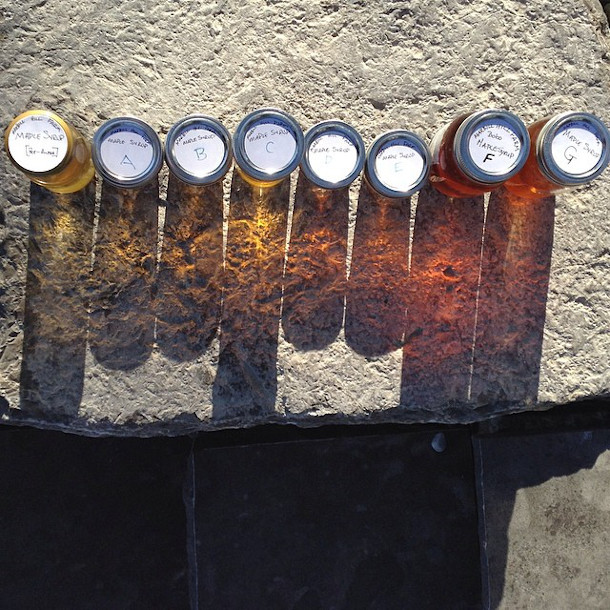
Maple syrup is classified into different grades. A darker syrup indicates a stronger flavor. (Photo: LexnGer, Flickr, CC BY-NC 2.0)
BASCOMB: These warm days and cold nights of spring mean it’s maple syrup season in much of the northeast. And like the crocuses that pop up through cold spring soil, sap buckets start to appear on maple trees across the region. But I recently visited a tree farmer in New Hampshire who produces syrup from other kinds of trees.
[WALKING SOUNDS]
BASCOMB: David Moore leads the way down a wide dirt path on his farm in Lee, New Hampshire. The path is lined on either side by stone walls built by farmers more than 200 years ago in the typical New England style. Those farmers were likely tapping maple trees this time of year. A skill no doubt learned from Native Americans in the region who have a long tradition with maple syrup. But David Moore is turning centuries of syrup making on its head.
MOORE: So, I have five beech trees tapped here. American beech. You need a vacuum pump to extract sap. Maple and birch, the sap will come out of the tree without a vacuum but other species you need a vacuum.
BASCOMB: Light blue plastic tubes jut out from each of the 5 beech trees in this stand. Another tube runs through a vacuum pump covered by an inverted plastic bin and into a plastic bucket.
[OPENING BUCKET SOUNDS]
BASCOMB: David takes the top of the bucket. Inside, a couple inches of frozen beech sap.
MOORE: Maybe one gallon or so. So this is about what I've been getting from these trees.
BASCOMB: David tells me he had more luck tapping a different set of beech trees last year and got a lot more sap. Still, he’ll need something like 200 gallons of beech sap to get one gallon of syrup. The sugar content for good old maple syrup is far more concentrated. So it takes just 40 gallons of maple sap to make a gallon of syrup.
MOORE: So nothing will replace maples. But it'll certainly add some value to your operation if you can do it.
BASCOMB: And that is David’s goal here. For his PhD work at the University of New Hampshire, he wants to figure out the best trees, other than maple, to tap and make syrup. It could be useful information for maple syrup producers in the region. They could use their existing equipment to tap other kinds of trees on their lan and make more money.
MOORE: Just getting a little more value out of your woods and especially with beech. Beech around here is thought to be just a really weedy kind of a nuisance species. And so if there's if there's a good use for it, then… yeah, just good for the producer.
BASCOMB: More than 20 different species of trees can be used to make syrup. Here on the farm, David is experimenting with basswood, poplar, hickory, sycamore and the beech he’s been showing me. Right now most alternative syrups are a lot more expensive than maple, largely because that sap to syrup ratio is so much higher. Still, David says there is a niche market for his syrups.
MOORE: I would sell to farmers markets in the beginning and specialty food stores. Several different restaurants, and also a lot of mail orders.
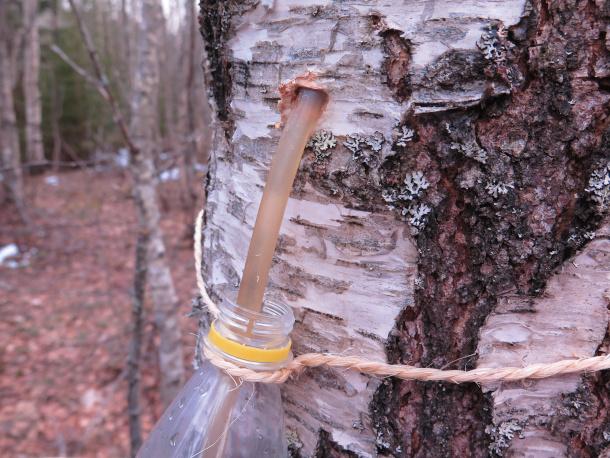
Harvesting sap from a birch tree. Maple trees are not the only sources to make syrup. (Photo: Ole Husby, Flickr, CC BY-SA 2.0)
BASCOMB: I’ve never had anything other than maple syrup so to see what I’ve been missing out on he invites me try a couple.
[CLINKING OF SILVERWARE, PLATES]
MOORE: Alright, so I have some birch syrup that I made. And some beech syrup from upstate New York from my friend Mike. So, should we try the birch first?
BASCOMB: Yeah, sounds great.
[BOTTLE OPENING SOUND]
MOORE: there you go.
BASCOMB: Thank you. It looks really really dark, much darker and thicker than maple syrup usually is. Yeah, let me try it. Let me take off the mask here. Wow. It's different. Yeah, it's sweet. It's definitely sweet, but also not at the same time somehow. It's got like a familiar flavor that I can't quite put my finger on.
MOORE: Miso?
BASCOMB: Miso! I don't know about that. Maybe molasses.
MOORE: It's nice as a glaze on red meat and salmon. Yeah. And it's also nice if you mix it with olive oil and balsamic vinegar to make a salad dressing. Should we try some beech?
BASCOMB: Yeah, sounds great.
[FAINT SOUND OF TASTING]
BASCOMB: That is a lot more like maple syrup.
MOORE: Yeah.
BASCOMB: Yeah, it's really good. I wouldn't I wouldn't think this isn't maple syrup. If you've put this on a pancake and gave it to me.
MOORE: I think if we had walnut syrup, here, you would have the same reaction tastes a lot like maple with a little more maybe nuttiness to it. But yeah, birch is pretty different Sycamore I would say is pretty different. So, yeah, cool. I'm glad you like them.
BASCOMB: Yeah, I really do. And I have to say, I really learned something new today. I had no idea before, you know, coming out here to meet you that you can make syrup out of anything but maple. So you really opened my eyes today.
MOORE: Yeah, thanks, Bobby. Thanks for coming out. This was a lot of fun.
BASCOMB: Yeah, it was Thank you.
Even before David Moore finishes his PhD at the University of New Hampshire he may find his research is in high demand. With the changing climate maple syrup production can be a lot more variable. Making alternatives more attractive. I hear sycamore actually tastes like butterscotch or honey but there wasn’t any ready yet for me to try on David’s farm. Maybe next time.
Related links:
- Click here for more on how maple syrup is made
- Read more about making syrup from birch and hickory trees
[MUSIC: Gary Burton, “Clarity” on Next Generation, by Julian Lage, Concord Records]
CURWOOD: Living on Earth is produced by the World Media Foundation. Our crew includes Naomi Arenberg, Paloma Beltran, Grace Callahan, Jenni Doering, Jay Feinstein, Paige Greenfield, Mark Seth Lender, Don Lyman, Aynsley O’Neill, Jake Rego, Natalie Seo, and Jolanda Omari.
BASCOMB: Tom Tiger engineered our show. Alison Lirish Dean composed our themes. Special thanks this week to Destination Wildlife. You can hear us anytime at L-O-E dot org, Apple Podcasts and Google Podcasts, and like us, please, on our Facebook page - Living on Earth. We tweet from @livingonearth. And find us on Instagram at livingonearthradio. I’m Bobby Bascomb
CURWOOD: And I’m Steve Curwood, Thanks for listening!
ANNOUNCER: Funding for Living on Earth comes from you, our listeners, and from the University of Massachusetts, Boston, in association with its School for the Environment, developing the next generation of environmental leaders. And from the Grantham Foundation for the protection of the environment, supporting strategic communications and collaboration in solving the world’s most pressing environmental problems.
ANNOUNCER 2: PRX.
Living on Earth wants to hear from you!
Living on Earth
62 Calef Highway, Suite 212
Lee, NH 03861
Telephone: 617-287-4121
E-mail: comments@loe.org
Newsletter [Click here]
Donate to Living on Earth!
Living on Earth is an independent media program and relies entirely on contributions from listeners and institutions supporting public service. Please donate now to preserve an independent environmental voice.
NewsletterLiving on Earth offers a weekly delivery of the show's rundown to your mailbox. Sign up for our newsletter today!
 Sailors For The Sea: Be the change you want to sea.
Sailors For The Sea: Be the change you want to sea.
 The Grantham Foundation for the Protection of the Environment: Committed to protecting and improving the health of the global environment.
The Grantham Foundation for the Protection of the Environment: Committed to protecting and improving the health of the global environment.
 Contribute to Living on Earth and receive, as our gift to you, an archival print of one of Mark Seth Lender's extraordinary wildlife photographs. Follow the link to see Mark's current collection of photographs.
Contribute to Living on Earth and receive, as our gift to you, an archival print of one of Mark Seth Lender's extraordinary wildlife photographs. Follow the link to see Mark's current collection of photographs.
 Buy a signed copy of Mark Seth Lender's book Smeagull the Seagull & support Living on Earth
Buy a signed copy of Mark Seth Lender's book Smeagull the Seagull & support Living on Earth

